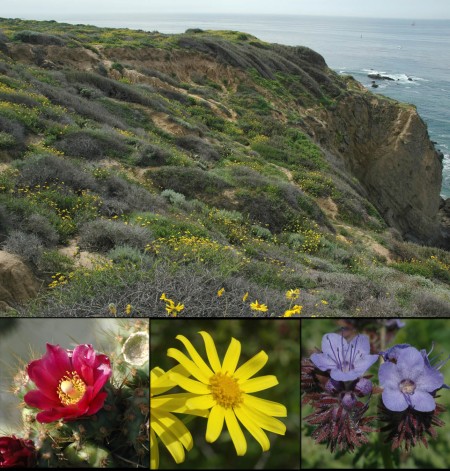In this Email:
1. General Meeting, February 19, 2009
2. Native Gardening Symposium, March 28, 2009
3. Field Trip, Starr Ranch, March 1, 2009
4. Invasive Plant Removal, Casper’s Park, March 1, 2009
1. General Meeting, February 19, 2009
LOCATION and TIME of meeting:
Duck Club, Riparian View Way, Irvine
(see http://occnps.org/ for directions)
Doors open at 6:45 pm
Circumvista allenii at 7:15 pm
Main program at 7:30 pm
The Dana Point Headlands—Past and Present
Speaker: Fred Roberts
The Dana Point Headlands is a coastal promontory in southern Orange County. Considering its isolation and size, it has a remarkable diversity of rare plants as well as many other interesting plants associated with coastal bluff scrub and heavy clay soils. Among its most famous are Blochmann’s dudleya (Dudleya blochmaniae), cliff spurge (Euphorbia misera), Nuttall’s scrub oak (Quercus dumosa), and Coulter’s saltbush (Atriplex coulteri). Recently, aphanisma (Aphanisma blitoides) and seaside calandrinia (Calandrinia maritima) were added to the list. The former is cryptic and very rare on the mainland. The latter had been known from Orange County only from an old 1932 Laguna Beach record. The Headlands is also one of the few places were the Pacific pocket mouse can be found and it supports a small but remarkably determined group of California gnatcatchers.
The Dana Point Headlands marked one of the opening stages in the chapter’s long conservation history with a letter to the County of Orange, dated May 1983. Since that time the area has been proposed for various developments and sought after as a prize for conservation and our chapter was in the thick of it. The US Fish and Wildlife Service and CDFG virtually wrote it off in their NCCP/HCP. However a decision by the California Coastal Commission in 2005 resulted in substantial conservation. Even then, there were still rumors that this coastal jewel had perished in the process. This is not the case.
Today, the City of Dana Point manages the hill top section of the Headlands while the Center for Natural Lands Management manages the bluffs and cliffs. Fred Roberts, our speaker, conducted extensive surveys on the CNLM portion in 2008 and will share his experiences and photos about the CNLM Dana Point Preserve. He will also share his knowledge of the Dana Point Headlands, past and present.

2. Native Gardening Symposium, March 28, 2009
At Home with Natives:
Creating and maintaining an authentic California landscape
An all-day symposium on NATIVE PLANT GARDENING
Golden West College Native Garden
Huntington Beach, CA 92647
TALKS GARDEN TOUR PLANT SALE BOOK SALE MORE!
Hosted by: Golden West College Native Garden &
California Native Plant Society, Orange County Chapter
Creating and growing beautiful water-wise gardens with California native plants is the theme of this all-day symposium. The program is designed for both homeowners and landscape professionals seeking to increase their knowledge about landscaping with native plants.
Morning Program: Speakers include: Dan Songster of Golden West College, Bart O’Brien and Barbara Eisenstein of Rancho Santa Ana Botanic Garden and Debbie Evans of Tree of Life Nursery.
Afternoon Program: Following a lunch for attendees in the Golden West College Native Garden, there will be tours of the garden highlighting maintenance techniques and design features, along with an opportunity to purchase plants and books related to native horticulture.
Registration Fee: $45.00. lunch included.
$35.00 for Friends of GWC Native Garden and CNPS members.
More information and registration material to come soon.
3. Field Trip, Starr Ranch, March 1, 2009, 8:30 am to Noon
Leader: Dick Newell
Come enjoy the coastal sage scrub, chaparral, oak woodland and riparian habitats that characterize the Audubon’s 4,000-acre Starr Ranch Sanctuary. Wildlife species include lizards, canyon tree frogs, red-shouldered hawks and mountain lions.
Downloadable checklists for mammals, birds, fishes, amphibians, reptiles and of course flora are available on the ranch’s website, http://www.starr-ranch.org, and clicking the “Checklists” tab, upper right.
You may wish to bring a light lunch. We usually sit around after this hike to contemplate the beauty and peacefulness of the canyon. To learn more about local plants and their relationship with the animals that use them for food and cover, check out www.octrackers.com.
Check the occnps.org website for directions. Go to “JanuaryFebruaryNewsletter” link on the left side of the main page, and then click on “Field Trips 2009”.
4. Invasive Plant Removal, March 1, 2009
Make a difference to the environment and help to remove Castor bean and Spanish broom (those nasty invaders!!) from Caspers Wilderness Park. Our trip leader will be Bill Neill, Invasive Exotics Committee chair for our chapter. Currently our trip is scheduled for the morning, although the time is subject to change. Don’t worry if you’d rather go on the field trip (above) – we will have future dates at Caspers. But if you have an interest in this project, for either now or the future, please contact Laura Camp at laurac@treeoflifenursery.com for more details.
To be removed from this email list, please “Reply” and request to be unsubscribed.